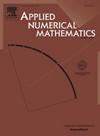具有浅层神经网络的三阶有限差分加权本质非振荡格式
IF 2.4
2区 数学
Q1 MATHEMATICS, APPLIED
引用次数: 0
摘要
在这项工作中,我们开发了基于神经网络的双曲守恒律的有限差分加权本质非振荡(WENO)格式。采用监督学习,训练数据由三点模板组成,并以相应的WENO3-JS权重作为标签。我们设计了两个损失函数,一个基于均方误差,另一个基于均方对数误差。每个损失函数由两个部分组成,其中第一个部分强制模型保持本质上的非振荡行为,而第二个部分减少了不连续点周围的耗散并提高了平滑区域的性能。为了提高计算效率,我们选择了浅层神经网络(SNN),并使用Delta层对输入进行预处理。所得WENO3-SNN方案在一维示例中优于经典WENO3-JS和WENO3-Z,并且在二维示例中表现出与WENO3-JS和WENO3-Z相当的性能。本文章由计算机程序翻译,如有差异,请以英文原文为准。
A third-order finite difference weighted essentially non-oscillatory scheme with shallow neural network
In this work, we develop the finite difference weighted essentially non-oscillatory (WENO) scheme based on the neural network for hyperbolic conservation laws. Supervised learning is employed with the training data consisting of three-point stencils and the corresponding WENO3-JS weights as labels. We design two loss functions, one built on the mean squared error and the other from the mean squared logarithmic error. Each loss function consists of two components, where the first enforces the model to maintain the essentially non-oscillatory behavior while the second reduces the dissipation around discontinuities and improves the performance in smooth regions. We choose the shallow neural network (SNN) for computational efficiency with the Delta layer pre-processing the input. The resulting WENO3-SNN schemes outperform the classical WENO3-JS and WENO3-Z in one-dimensional examples, and show comparable sometimes superior simulations to WENO3-JS and WENO3-Z in two-dimensional examples.
求助全文
通过发布文献求助,成功后即可免费获取论文全文。
去求助
来源期刊

Applied Numerical Mathematics
数学-应用数学
CiteScore
5.60
自引率
7.10%
发文量
225
审稿时长
7.2 months
期刊介绍:
The purpose of the journal is to provide a forum for the publication of high quality research and tutorial papers in computational mathematics. In addition to the traditional issues and problems in numerical analysis, the journal also publishes papers describing relevant applications in such fields as physics, fluid dynamics, engineering and other branches of applied science with a computational mathematics component. The journal strives to be flexible in the type of papers it publishes and their format. Equally desirable are:
(i) Full papers, which should be complete and relatively self-contained original contributions with an introduction that can be understood by the broad computational mathematics community. Both rigorous and heuristic styles are acceptable. Of particular interest are papers about new areas of research, in which other than strictly mathematical arguments may be important in establishing a basis for further developments.
(ii) Tutorial review papers, covering some of the important issues in Numerical Mathematics, Scientific Computing and their Applications. The journal will occasionally publish contributions which are larger than the usual format for regular papers.
(iii) Short notes, which present specific new results and techniques in a brief communication.
 求助内容:
求助内容: 应助结果提醒方式:
应助结果提醒方式:


